David Mubiana will always remember the day he was shot. It happened in 2002, when his unit was ambushed by poachers with AK-47 rifles and a shotgun. He was wounded in the arm and stomach; one bullet rupturing his spleen. As a wildlife police officer in Zambia’s Department of National Parks and Wildlife, his job is inherently risky.
“Even if you fall down, you have to stand up and continue fighting. If we finish our wildlife, [our children] are not going to see what we are seeing today,” he says.

-
David Mubiana puts his life on the line to watch over straw-coloured fruit bats and other wildlife in Kasanka national park
Like other wildlife protectors, he puts his life on the line every day. But not every animal needing protection is a big beast. Following the incident in 2002 in a park bordering Angola, Mubiana was transferred to Kasanka national park in central Zambia, where he now protects one of nature’s mysteries – and the biggest mammal migration in the world – from poachers and land encroachment. These poachers may be after antelope and elephants, but their actions also pose a threat to the straw-coloured fruit bat, Eidolon helvum.

-
The straw-coloured fruit bat is listed as near threatened by the International Union for Conservation of Nature
Every year, between October and December, 8-10 million straw-coloured fruit bats descend on the park to feast on an abundance of fruit. From west Africa, over the forests of the Congo basin and on to Zambia, the bats migrate thousands of kilometres over savanna and open land, dispersing seeds into deforested areas, and reforesting and regenerating landscapes on their journey. Scientists are still trying to fathom why these fruit bats, or “flying foxes”, gather at Kasanka in numbers not seen anywhere else. Each night they leave their evergreen swamp fig roosts to fly up to 55 miles (90km) in search of wild berries and fruit.
Listed as near threatened on the International Union for Conservation of Nature’s red list, the straw-coloured fruit bat is one of the largest fruit bats in Africa. There are fears that if their numbers drop below a certain amount, the colony may not be able to keep going. “If that turns out to be true, we might be in trouble,” says Dr Dina Dechmann of the Max Planck Institute of Animal Behavior, whose team has studied the bats for 12 years.
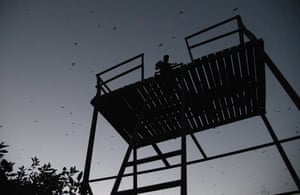
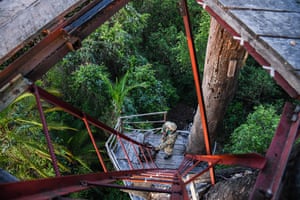
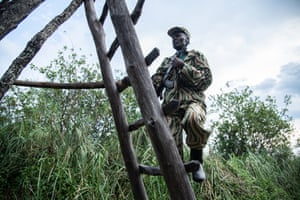
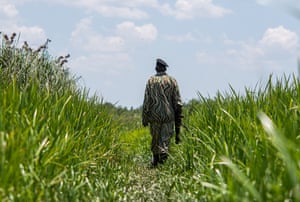
-
Wildlife scouts use watchtowers and patrol the park on foot to stop poachers and illegal acts of deforestation
While sightings have revealed where the bats have been spotted, the precise route they take is unknown. Dechmann’s teams is about to deploy satellite trackers to follow the migration. “I think this bat is crucial for Africa – more than most other species in that [they] cover long distances,” says Dechmann. “If you think about seed dispersal, antelopes, monkeys, birds, you name it – even most other bats – they will not leave the protection of the forest canopy, so they are not as effective as seed dispersers. If you have a colony like in Kasanka with several million bats, if each disperses one seed every night – that’s huge.”

With the onset of the Covid-19 pandemic, the bats have faced a new threat from humans seeking to attack them. “These bats are being persecuted because of ongoing publicity about their role as virus hosts. Their importance completely outweighs the potential threat,” says Dechmann, adding that their role in transmitting viruses such as Covid-19 directly to humans has not been scientifically proved.
Helen Taylor-Boyd at Bats without Borders, a conservation group in southern Africa, says: “We’ve got to put this in a larger context: the context is the risk is increased by humans encroaching into animal habitat … [Wild animals] are best left well alone, and human encroachment is not a wildlife-caused problem.”
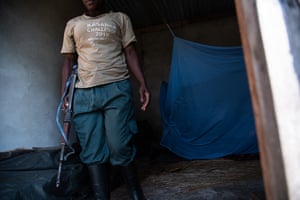



-
Kasanka Trust has employed 30 new scouts to prevent illegal deforestation and stop poaching in the park
But habitat loss is fast becoming the park’s chief threat. As forests where bats roost and feed are lost, they are increasingly being forced out. “Bats will either need to forage farther, or they will remain in the same location and overuse resources. So it’s a habitat and wildlife management issue just as much as an urban-human bat conflict issue,” says Taylor-Boyd.
Deforestation across Zambia is alarmingly high at 250,000 to 300,000 hectares (620,000 to 740,000 acres) of forest a year. According to Kasanka Trust, which manages the park, 10,000 hectares of commercial farming has already encroached into a prohibited buffer zone around the park. The trust, which has lost 70% of its revenue due to the pandemic, has employed 30 new scouts to patrol with police officers like Mubiana to prevent illegal deforestation and encroachment.
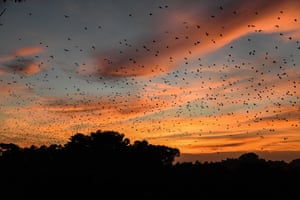
-
Since the outbreak of Covid-19 the bats have faced a new threat: they are being attacked because of their perceived role in the spread of the disease
The Kasanka Trust’s general manager, Richard Peel, says: “Emerging threats from commercial agriculture around the park are extremely dangerous and could bring an end to the bat migration if it’s not brought under control. This migration depends on healthy and intact forests within and around the park. The [bats] utilise more than 10 times the size of the national park, which highlights the importance of protecting the areas [within it].”
Areas surrounding the park are also critical for people who rely on the forest for food and income. The trust has helped communities gain legal ownership of 60,000 hectares of surrounding forest, supporting income-generating activities such as beekeeping. Churchill Musungwa, a voluntary forest guard, says his community decided to work with the trust after seeing land nearby destroyed.
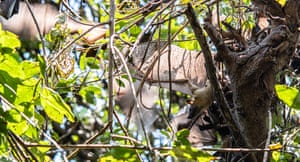
-
Commercial agriculture is causing habitat loss, which threatens the future of the straw-coloured bat
“If [we] protect the forest, we can benefit as a community in the coming years,” he says. “When we put up beehives we are going to sell the honey; have money to educate our children. We can push [for] our lives to be better.”

-
Community forest guards have put up beehives in the areas they manage to generate income for local people
Find more age of extinction coverage here, and follow biodiversity reporters Phoebe Weston and Patrick Greenfield on Twitter for all the latest news and features